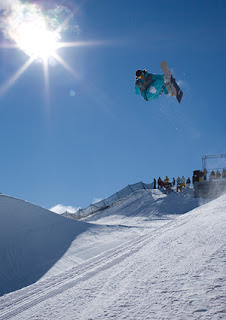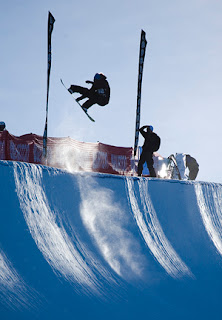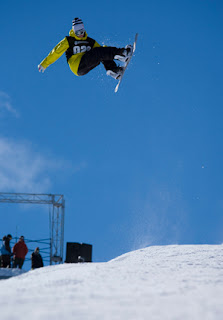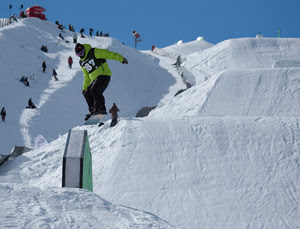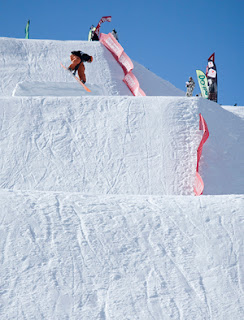Difficulty: Average
Time Required: practice
Here's How:
- The first element to going big on a snowboard is your speed. The faster you hit a jump, the farther you will be able to go off of it.
- Start at a point in the take off where you are comfortable going straight at the jump. Then pick a spot a little further uphill. Continue to build your speed by picking spots further uphill from the jump.
- The second element to going big on a snowboard is how hard you spring off of the lip of the jump. The trick here is to ollie, or jump, just as you take off. The harder you ollie, the higher and bigger you will go.
- To ollie off a jump, stay low with your knees bent as you approach the jump. Then, just as you are about to take off, spring off the tail of your snowboard while you lift up with your front foot.
- As you ascend into the air, bring both knees up toward your chest to continue your upward momentum.
- A good amount of speed combined with a good ollie is the key to going big on a snowboard. Extend your legs to land and ride away smooth!
Tips:
- Avoid speed checking -- turning to shed speed on your way to the jump. Instead, start from a lower spot to avoid too much speed and aim straight at the jump.
- Practice ollies on flat ground, then on rollers and other bumps in the snow until you are very comfortable with how they feel.
- Focus first on going big, then add in a grab or a trick once you are comfortable on the jump.
- As you land, focus on riding straight for a short while before you start turning to stop or slow down.
Difficulty: Easy
Time Required: up to an hour
Here's How:
- 1.Scout a location. Ideally, find a hill that starts off at a fair slope, then drops into a steeper section with a long enough run-out for a good landing. Build the jump just in front of the steeper section.
- Get out your snowboarding shovels (packable and lightweight with a big square shovel) and make a big pile of snow.
- Use snowboards as scaffolding for the front of the jump.
- Pack down the snow using a shovel or the base of a snowboard. Hold your board by its bindings and smooth out the top of the jump. If the hill drops naturally, you won't need a very steep lip.
- Smooth out the run-in with the base of a snowboard.
- Test it out! Make adjustments as necessary until everything feels just right. Have fun!
Tips:
- Take off in slightly different places to optimize the most good landings.
- The best way to learn a new trick is to practice it over and over on the same jump. Building a jump yourself will help you to quickly learn new tricks.
- Most resorts don't like you to build a jump within their boundaries. Go out-of-bounds if you can.
How To How To Do A Backside 180
A backside 180 is one of my favorite tricks. You can do it small while you're still learning, or huge and slow once you have it down. The technique is the same; the style is all yours.
Difficulty: Average
Time Required: Practice
Here's How:
- Ride straight at a small bump or roller with the base of your board flat.
Stay flat-based until you're just about to take off. - At the lip of the jump, spring off of your toes.
- Suck your legs up toward your chest and grab indy. (Once you've mastered the indy grab, experiment with grabbing mute, tail or doing a backside 180 method.)
- Rotate slowly because you're only going to spin 180 degrees.
- Look down between your legs to spot your landing.
Let go of your grab and extend your legs for the landing. - As you absorb the landing, continue looking uphill for just a second until your board is firmly planted. Then turn and ride away smoothly.
Tips:
- Try to land a little bit on your toeside edge at first to avoid catching your heelside edge as you come around. Then get used to landing flat-based.
How To How To Do An Indy Grab
An indy grab is the quintessential "first trick". Once you get the hang of it, you can experiment with style by trying it tuck-knee or by boning it out (straightening your front leg).
Difficulty: Easy
Time Required: Practice
Here's How:
Tips:
- As you improve, try adding an indy grab into your spins. But to sound cool, remember this: "indy" infers a backside spin; i.e. indy is never frontside. If you spin frontside and grab between your feet it is called a "frontside" grab.
Snowboarding Injuries
As the sport of snowboarding grows, so does the number of snowboarding-related injuries. Wrist injuries are by far the most common of all snowboarding injuries, followed by ankle and knee injuries.
Wrist injuries tend to occur when snowboarders fall backward and try to catch themselves with their arms. The instinct to extend one or both arms to catch a fall is hard to curb, but snowboarders should be advised to try to keep their arms safely tucked in. It is better to roll out of a fall, distributing impact over a greater portion of the body. Beginning snowboarders are at particular risk for wrist injury, most likely because beginners accumulate a greater number of backward falls at slower speeds than more advanced riders.
Wrist guards are the best protection against injury, but are not a sure thing. Snowboarders have suffered wrist injuries despite wearing wrist guards, suggesting a need for more snowboard-specific wrist protection. However, wrist guards are still the best method of injury prevention, and are especially important during the first week of learning to snowboard. Some glove manufacturers make gloves with integrated wrist protection. Wrist guards made for inline skating or skateboarding can also work for snowboarding, and can be worn either under or on the outside of mittens or gloves.
Ankle injuries can also occur while snowboarding, and are more common among riders who prefer a soft boot. Riders who opt for stiffer lace-up boots or alpine/carving boots are less likely to have ankle injuries, but may be more prone to knee injuries.
Helmets are increasing in popularity in many sports, snowboarding included. Head injuries can occur due to impact with hard snow or ice as well as trees and other objects. Helmets are an essential component of any snowboarder's protective gear, regardless of ability. Several helmets are on the market that have been developed specifically for sports such as skiing and snowboarding, including helmets designed for kids.
Taking a lesson is always the best way to start snowboarding, and can be a great way to reduce the risk of injury. Experienced snowboard instructors can teach beginners how to fall as well as how to stay up, and both can be vital skills to have for an enjoyable day on the slopes.






















